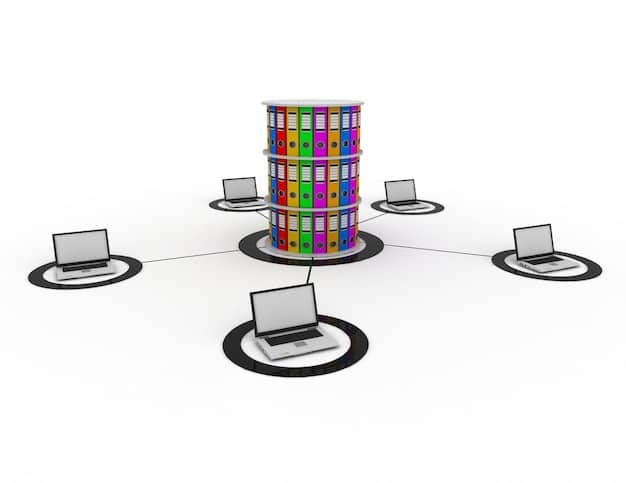Understand Cookies: How Websites Track You & How to Block Them

Cookies are small data files stored by websites on your device, enabling them to remember information about you, track your online activities, and personalize experiences; understanding and managing these can significantly enhance your privacy and digital security.
In our increasingly digital world, navigating the internet often feels like a seamless experience, yet behind the scenes, complex mechanisms are constantly at play to shape what you see, where you go, and how your data is handled. One of the most fundamental, though often misunderstood, of these mechanisms involves web cookies. To
What Exactly Are Web Cookies?
Web cookies, often simply called “cookies,” are small text files that websites send to your device (computer, tablet, smartphone) through your web browser. They serve various purposes, primarily designed to make your browsing experience more efficient and personalized. Think of them as tiny digital memory notes that a website leaves on your device.
When you visit a website, it might place one or more cookies on your system. The next time you visit that same website, your browser sends these cookies back to the server. This exchange allows the website to recognize you, retrieve stored information about your previous interactions, and tailor your experience accordingly. This basic functionality is what facilitates many of the conveniences we now take for granted online.
The Genesis and Evolution of Cookies
The concept of the web cookie was created in 1994 by Lou Montulli, an engineer at Netscape, to solve the problem of persistent user states in stateless HTTP connections. Initially, they were designed to recognize unique users across pages, enabling features like shopping carts. Over time, their applications expanded far beyond simple session management to include tracking, personalization, and advertising.
- Early Functionality: Primarily for session management and remembering user preferences like language settings.
- Commercial Adoption: Quickly embraced by e-commerce sites to maintain shopping cart contents.
- Expansion to Analytics: Used to track user behavior for website analytics and performance improvements.
- Rise of Third-Party Tracking: Advertisers began leveraging cookies to build detailed user profiles across multiple websites.
The proliferation of cookies led to increasing concerns about user privacy. As their capabilities grew, so did the debate around data collection and user consent. This evolution has driven regulatory responses worldwide, leading to stricter rules about how cookies are used and how users are informed about them.
How Cookies Work Behind the Scenes
The technical process of how cookies work is relatively straightforward. When you navigate to a website, the web server sends a “Set-Cookie” HTTP header to your browser. Your browser then stores this small piece of data. When you request another page from the same website, your browser includes the cookie in the “Cookie” HTTP header of your request. The server reads this cookie and can then act based on the information it contains.
This simple exchange is foundational to how many modern web applications function. Without cookies, every interaction on a website would be treated as if it were your first visit, making tasks like logging in, adding items to a cart, or remembering display preferences virtually impossible without constant re-entry of information.
Types of Cookies and Their Functions
Not all cookies are created equal, and understanding their different types is crucial for grasping how they impact your online experience and privacy. Generally, cookies can be categorized by their duration and their origin, each serving distinct purposes.
Session Cookies vs. Persistent Cookies
These two categories define how long a cookie remains on your device:
- Session Cookies: These are temporary cookies that exist only while you are actively browsing a website. They are stored in volatile memory and are erased once you close your browser. Their primary function is to enable the website to recognize your actions during a single browsing session, such as keeping you logged in or remembering items in your shopping cart on an e-commerce site. They are essential for the basic functionality of many web applications.
- Persistent Cookies: Unlike session cookies, persistent cookies remain on your device for a specified period (which can range from minutes to years, or until you manually delete them). They are used to remember your preferences and settings across multiple visits to a website. Examples include remembering your login details, language preferences, or personalized content recommendations. They enhance convenience by making subsequent visits smoother and more tailored to your past activities.
The choice between session and persistent cookies depends on the website’s needs. Session cookies are ideal for short-term, in-session functions, while persistent cookies are vital for long-term user recognition and personalization.
First-Party Cookies vs. Third-Party Cookies
The origin of a cookie determines who sets it and, consequently, who can access the information it collects:
- First-Party Cookies: These cookies are set directly by the website you are visiting (the domain shown in your browser’s address bar). They are generally considered benign and are used to provide core site functionalities. For example, a first-party cookie might remember your login status or items in your shopping cart. They are integral to user experience and are typically not viewed as privacy concerns by users, as they facilitate direct interaction with the site you’ve chosen to visit.
- Third-Party Cookies: These cookies are set by a domain other than the one you are currently visiting. They are often embedded by third-party services integrated into a website, such as analytics providers, social media widgets, or advertising networks. Third-party cookies are primarily used for tracking your browsing behavior across multiple websites to build a profile for targeted advertising, analytics, or social media interaction. These are the cookies that raise the most significant privacy concerns because they enable companies to track your online activities across potentially countless sites without your direct knowledge or explicit consent in every instance.
Understanding the distinction between first-party and third-party cookies is fundamental to comprehending online tracking. While first-party cookies enhance your direct interaction with a site, third-party cookies facilitate a broader network of data collection that extends beyond the specific website you’re visiting.

How Websites Use Cookies to Track You
The concept of “tracking” via cookies extends far beyond simply remembering your login. Websites, and the third-party services they integrate, leverage cookies to gather insights into user behavior, preferences, and demographics. This data is then used for various purposes, from enhancing user experience to highly targeted advertising.
Personalization and User Experience
One of the most obvious uses of cookies is to personalize your online experience. This includes:
- Remembering Login Credentials: Storing your username allows for faster login on subsequent visits.
- Shopping Cart Persistence: Keeping items in your cart even if you leave the site and return later.
- Language and Region Settings: Displaying content in your preferred language or showing prices in your local currency.
- Content Recommendations: Suggesting articles, products, or videos based on your past browsing or viewing history.
These functionalities, driven by first-party persistent cookies, are generally beneficial and designed to make your web interactions more convenient and efficient. They aim to create a tailored digital environment that anticipates your needs and preferences, streamlining your access to information and services.
Behavioral Tracking and Advertising
The more controversial aspect of cookies lies in their use for behavioral tracking, particularly through third-party cookies. This involves monitoring your activities across different websites to construct a detailed profile of your interests, habits, and even purchasing power. This profile is then used for:
- Targeted Advertising: Showing you ads that are highly relevant to your inferred interests. If you search for “running shoes” on one site, you might then see ads for running shoes on entirely unrelated websites.
- Retargeting: Displaying ads for products or services you’ve previously viewed or interacted with on a specific site, even after you’ve left that site.
- Frequency Capping: Preventing the same ad from being shown to you too many times, improving ad effectiveness and user experience.
- Performance Measurement: Tracking whether an advertisement led to a purchase or a sign-up, helping advertisers optimize their campaigns.
This form of tracking raises significant privacy concerns. While websites and advertisers argue it provides a more relevant ad experience and supports free online content, users often feel their privacy is invaded. The data collected can be aggregated, sold, and used in ways that are not always transparent to the individual, leading to a loss of control over personal information.
Analytics and Website Improvement
Cookies are also indispensable tools for website owners to understand how their sites are being used. Analytics cookies collect anonymous information about:
- Visitor Counts: How many unique visitors a site receives.
- Page Views: Which pages are most popular and how long users spend on them.
- Navigation Paths: How users move through a website, identifying common entry and exit points.
- Technical Issues: Identifying browser types, device types, and potential errors, helping webmasters optimize site performance and compatibility.
This data is typically aggregated and anonymized, providing broad insights rather than tracking individual users directly. It helps website owners make data-driven decisions to improve site navigation, content, and overall user experience, ultimately leading to a more effective and engaging online presence.
The Privacy Implications of Cookies
While cookies offer undeniable benefits for website functionality and user experience, their privacy implications are a subject of ongoing debate and concern. The ability to collect, store, and share data about individual browsing habits raises significant questions about surveillance, data security, and personal autonomy.
Data Collection and Profiling Risks
The primary privacy risk associated with cookies, particularly third-party cookies, is the extensive data collection and profiling capabilities they enable. Every website you visit that uses third-party advertising or analytics cookies contributes to a larger digital profile about you. This profile can include:
- Demographic Information: Inferred age, gender, location, and income level.
- Interests: Based on websites visited, content viewed, and products researched.
- Online Behavior: Time spent on pages, links clicked, purchase history, and even typing patterns.
This detailed profiling occurs often without direct user awareness or explicit consent for each piece of data. This data can then be used not only for targeted advertising but also for other purposes, such as influencing political campaigns, determining creditworthiness, or even enabling dynamic pricing based on a user’s perceived spending habits. The aggregation of this data creates a comprehensive digital shadow that can be difficult for individuals to control or erase.
Security Vulnerabilities (Cookie Theft and Session Hijacking)
Beyond data collection, cookies can also pose security risks if not properly secured. Two common threats include:
- Cookie Theft (Cross-Site Scripting – XSS): Malicious actors can exploit vulnerabilities in websites to inject scripts that steal cookies from users’ browsers. If these stolen cookies contain session IDs, an attacker can use them to impersonate the legitimate user, gaining unauthorized access to their accounts without needing a password. This is particularly dangerous for logged-in sessions on sensitive sites like banking or email services.
- Session Hijacking: This occurs when an attacker intercepts and takes over a legitimate user’s active session. While not always directly involving cookie theft, weak cookie security (e.g., using unsecured HTTP instead of HTTPS) can make sessions vulnerable to interception. Once a session is hijacked, the attacker can perform actions within the user’s account as if they were the user.
To mitigate these risks, websites are encouraged to implement secure cookie practices, such as using HTTPS to encrypt data transmission, setting the “HttpOnly” flag to prevent client-side script access to cookies, and using the “Secure” flag to ensure cookies are only sent over encrypted connections. Users also play a role by ensuring their browser and operating system are up-to-date and by being wary of suspicious links.
Regulatory Responses (GDPR, CCPA, etc.)
Growing public concern about cookie tracking and its privacy implications has led to significant regulatory action worldwide. Key regulations include:
- General Data Protection Regulation (GDPR) in the EU: Implemented in 2018, GDPR requires websites to obtain explicit and informed consent from users before placing most non-essential cookies. It grants individuals extensive rights over their personal data, including the right to access, rectify, and erase data collected via cookies. Consent banners and preference centers became commonplace due to GDPR.
- California Consumer Privacy Act (CCPA) in the US: Effective in 2020, CCPA gives California residents the right to know what personal information is being collected about them, the right to request its deletion, and the right to opt out of the sale of their personal information. While not as stringent on consent as GDPR, CCPA significantly impacts how businesses handle and share data collected through cookies for commercial purposes.
- Other Global Regulations: Many other countries and regions are enacting or considering similar data protection laws, reflecting a global trend towards greater privacy protection. Examples include LGPD in Brazil, POPIA in South Africa, and various laws in Asian countries.
These regulations aim to give users more control over their data and transparency into how it’s used. They have pushed websites to adopt more privacy-centric approaches, though challenges remain in ensuring full compliance and effective user empowerment.
How to Manage and Block Cookies
Given the privacy implications, many users opt to manage or even block cookies. Fortunately, modern web browsers offer a range of tools and settings to help you control your digital footprint. Taking proactive steps can significantly enhance your online privacy and security.
Browser Settings and Controls
Your web browser is your primary tool for managing cookies. Most browsers provide granular control over how cookies are handled:
- Blocking Third-Party Cookies: Almost all major browsers (Chrome, Firefox, Edge, Safari) allow you to block third-party cookies by default. This is a crucial step in preventing cross-site tracking by advertisers and analytics services. While this might occasionally break some website functionalities that rely on third-party integrations, it significantly enhances privacy.
- Deleting Existing Cookies: You can typically clear all cookies from your browser history. This removes all stored cookie data, effectively logging you out of most websites and resetting your personalized settings. It’s a good practice for a privacy refresh, though it means you’ll need to re-enter login details and preferences on subsequent visits.
- Website-Specific Cookie Management: Some browsers allow you to manage cookies on a site-by-site basis. For instance, you can choose to allow cookies only from specific trusted websites while blocking them from all others. This offers a more nuanced approach than a blanket block.
- “Do Not Track” (DNT) Requests: Many browsers include a “Do Not Track” setting, which sends a signal to websites indicating your preference not to be tracked. However, this is largely an honor system, and websites are not legally required to respect this signal. Its effectiveness varies widely.
Regularly reviewing and adjusting your browser’s cookie settings is an effective way to maintain control over your privacy. It empowers you to decide how much data websites can store about your browsing habits.
Utilizing Browser Extensions and Privacy Tools
Beyond built-in browser settings, numerous third-party extensions and software tools are designed to enhance cookie management and block tracking:
- Ad Blockers with Tracking Protection: Many popular ad blockers (e.g., uBlock Origin, AdBlock Plus) also include features to block tracking scripts and cookies from known advertising and analytics domains. These tools can significantly reduce the amount of data collected about you.
- Privacy-Focused Extensions: Extensions like Ghostery, Privacy Badger, and Disconnect are specifically designed to identify and block third-party trackers, including those using cookies. They often provide detailed insights into which trackers are present on a website.
- VPNs (Virtual Private Networks): While not directly managing cookies, a VPN encrypts your internet connection and masks your IP address, making it harder for websites and third parties to link your online activity to your physical location or real identity. This adds another layer of privacy protection.
- Private Browsing Modes: Incognito mode (Chrome), Private Browsing (Firefox/Safari), or InPrivate Browsing (Edge) open a temporary session where cookies (and history, cache, etc.) are not saved on your device once the session is closed. This is useful for temporary browsing activities where you don’t want a persistent record.
Combining browser settings with privacy-focused extensions can create a robust defense against unwanted cookie tracking, offering a more secure and private browsing experience. It’s important to research and choose reputable extensions to avoid inadvertently installing malicious software.
Website Consent Banners and Your Choices
Thanks to regulations like GDPR and CCPA, most websites now display cookie consent banners upon your first visit. These banners are designed to inform you about the types of cookies being used and to request your consent. It’s crucial to interact with these banners thoughtfully:
- Read Before Clicking “Accept All”: While convenient, accepting all cookies often means consenting to extensive tracking.
- Look for “Manage Preferences” or “Cookie Settings”: These options allow you to customize your preferences, often enabling you to selectively approve or deny specific categories of cookies (e.g., analytics, advertising, essential). Always prioritize allowing only essential cookies if privacy is your main concern.
- Understand the Impact of Opting Out: Be aware that opting out of certain cookies, especially functional ones, might affect a website’s usability or personalization. However, this is usually a minor trade-off for enhanced privacy.
Engaging with cookie consent banners, rather than dismissively clicking through them, is a direct way to exercise your rights and control the data collected about you. It represents a shift in responsibility towards the user, reinforcing the importance of informed consent in the digital landscape.
The Future of Cookies and Online Privacy
The landscape of online privacy is in constant flux, with significant shifts anticipated in how cookies are used and how users are tracked. The industry is grappling with the tension between personalized experiences and growing demands for privacy, leading to new initiatives and technologies.
The End of the Third-Party Cookie?
Perhaps the most significant development is Google’s plan to phase out third-party cookies in Chrome. While delayed, this initiative signals a broad industry move away from a tracking mechanism that has been foundational yet highly criticized. Google’s Privacy Sandbox initiative aims to replace third-party cookies with new technologies that enable interest-based advertising and conversion measurement while preserving user privacy by aggregating data and limiting individual tracking.
- Reduced Cross-Site Tracking: The primary goal is to limit the ability of advertisers to track users across unrelated websites directly via third-party cookies.
- New Privacy-Preserving APIs: Proposals include technologies like Topics API (for interest-based advertising) and FLEDGE (for remarketing), designed to keep user data on the device and share only aggregated, anonymized insights with advertisers.
- Industry Adaptations: This shift is forcing advertisers, publishers, and ad tech companies to re-evaluate their strategies, moving towards first-party data collection and contextual advertising.
While the deprecation of third-party cookies is hailed by privacy advocates as a positive step, some critics worry that it centralizes more power within Google’s ecosystem. The true impact on online advertising and user privacy remains to be seen as these new proposals are implemented and tested.
Emerging Tracking Technologies and Persistent Challenges
Even with the decline of third-party cookies, the world of online tracking is sophisticated and constantly evolving. New methods are emerging to persist in tracking users, posing ongoing challenges to privacy:
- Fingerprinting: This technique uses unique combinations of your device’s configuration (browser version, installed fonts, plug-ins, screen resolution, operating system) to create a “fingerprint” that can identify you, even without cookies. It’s much harder to block than cookies because it relies on standard system information.
- First-Party Data Strategies: Websites are increasingly focusing on collecting and leveraging their own first-party data directly from users (e.g., through logins, newsletter sign-ups, direct purchases). This data is often used in conjunction with “data clean rooms” or other privacy-enhancing technologies to share insights with advertisers without exposing individual user data.
- Login-Based Tracking: When you log into popular services (like Google, Facebook, Amazon), those companies can track your activity across their ecosystem and often across third-party sites where their widgets or login buttons are embedded, even without traditional third-party cookies.
These emerging methods suggest that while the tools of tracking might change, the fundamental challenge of balancing personalized services with user privacy will likely persist. Continuous vigilance and education for users will be essential.
The Role of User Education and Privacy-First Design
As tracking technologies become more complex, user education becomes paramount. Empowering individuals to understand how their data is collected and used is critical for informed decision-making. Furthermore, there’s a growing movement towards “privacy-by-design” and “privacy-by-default” principles, where privacy is built into products and services from the outset, rather than being an afterthought.
- Increased Transparency: Websites and services are expected to be more transparent about their data practices, using clear language rather than confusing legal jargon.
- User Control: Providing easily accessible and understandable controls for users to manage their data preferences.
- Ethical Data Use: A growing emphasis on using data ethically and responsibly, prioritizing user trust.
The future of online privacy will likely be shaped by a combination of technological innovations, stronger regulatory frameworks, and a more privacy-aware user base. While the “cookie apocalypse” for third-party cookies is on the horizon, the broader conversation about digital privacy and control is far from over.

| Key Aspect | Brief Description |
|---|---|
| 🍪 What are Cookies? | Small text files websites send to your browser to remember information about you. |
| 🕵️♂️ How They Track | Used for personalization, behavioral advertising (especially third-party), and analytics. |
| 🔒 Privacy Concerns | Data profiling, potential security vulnerabilities, and lack of user control over data. |
| 🛡️ Blocking Methods | Browser settings, privacy extensions, VPNs, and careful management of consent banners. |
Frequently Asked Questions About Cookies
No, not all cookies are inherently bad. First-party cookies are often essential for basic website functionality, like keeping you logged in or remembering items in a shopping cart. The primary privacy concern typically arises from third-party cookies, which are used to track your browsing across multiple websites for advertising and profiling purposes.
First-party cookies are set by the website you are directly visiting and are generally used for improving your experience on that specific site. Third-party cookies, however, are set by a domain other than the one you are on, often by advertisers or analytics services, and are primarily used for cross-site tracking and targeted advertising.
Most modern web browsers offer built-in settings to block third-party cookies. You can usually find this option in your browser’s privacy or security settings. Enabling this feature will limit the ability of external advertisers and trackers to monitor your activities across different websites, significantly enhancing your online privacy.
Blocking all cookies, especially first-party ones, can indeed interfere with website functionality. Many sites rely on cookies to maintain login sessions, remember preferences, or keep items in a shopping cart. It’s often more practical to block only third-party cookies or manage specific website permissions to balance privacy with usability.
Cookie consent refers to the process where websites ask for your permission before placing non-essential cookies on your device, primarily due to regulations like GDPR. It’s important because it gives you control over what data is collected about you, empowering you to accept or deny cookies based on your privacy preferences. Always review consent options carefully.
Conclusion
In the digital age, understanding web cookies is no longer merely technical jargon but a fundamental aspect of managing your online privacy. While they serve essential functions in personalizing and enhancing your web experience, their pervasive use, particularly by third parties, has transformed them into powerful tools for tracking and profiling. Navigating this complex landscape requires an informed approach, leveraging browser settings, privacy tools, and a critical eye on consent banners. As the internet evolves, with shifts like the deprecation of third-party cookies, the continuous conversation surrounding data privacy will undoubtedly shape future online interactions. Ultimately, your awareness and proactive choices remain your most effective defense in maintaining control over your digital footprint.





